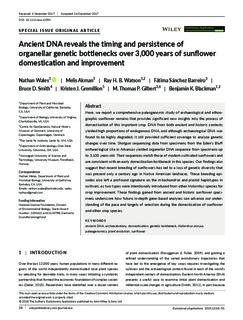| dc.contributor.author | Wales, Nathan | |
| dc.contributor.author | Akman, Melis | |
| dc.contributor.author | Watson, Ray H B | |
| dc.contributor.author | Sánchez Barreiro, Fatima | |
| dc.contributor.author | Smith, Bruce D | |
| dc.contributor.author | Gremillion, Kristen J | |
| dc.contributor.author | Gilbert, Marcus Thomas Pius | |
| dc.contributor.author | Blackman, Benjamin K | |
| dc.date.accessioned | 2019-09-24T07:51:36Z | |
| dc.date.available | 2019-09-24T07:51:36Z | |
| dc.date.created | 2019-05-09T12:28:42Z | |
| dc.date.issued | 2019 | |
| dc.identifier.citation | Evolutionary Applications. 2019, 12 (1), 38-53. | nb_NO |
| dc.identifier.issn | 1752-4571 | |
| dc.identifier.uri | http://hdl.handle.net/11250/2618374 | |
| dc.description.abstract | Here, we report a comprehensive paleogenomic study of archaeological and ethnographic sunflower remains that provides significant new insights into the process of domestication of this important crop. DNA from both ancient and historic contexts yielded high proportions of endogenous DNA, and although archaeological DNA was found to be highly degraded, it still provided sufficient coverage to analyze genetic changes over time. Shotgun sequencing data from specimens from the Eden's Bluff archaeological site in Arkansas yielded organellar DNA sequence from specimens up to 3,100 years old. Their sequences match those of modern cultivated sunflowers and are consistent with an early domestication bottleneck in this species. Our findings also suggest that recent breeding of sunflowers has led to a loss of genetic diversity that was present only a century ago in Native American landraces. These breeding episodes also left a profound signature on the mitochondrial and plastid haplotypes in cultivars, as two types were intentionally introduced from other Helianthus species for crop improvement. These findings gained from ancient and historic sunflower specimens underscore how future in‐depth gene‐based analyses can advance our understanding of the pace and targets of selection during the domestication of sunflower and other crop species. | nb_NO |
| dc.language.iso | eng | nb_NO |
| dc.publisher | Wiley | nb_NO |
| dc.rights | Navngivelse 4.0 Internasjonal | * |
| dc.rights.uri | http://creativecommons.org/licenses/by/4.0/deed.no | * |
| dc.title | Ancient DNA reveals the timing and persistence of organellar genetic bottlenecks over 3,000 years of sunflower domestication and improvement | nb_NO |
| dc.type | Journal article | nb_NO |
| dc.type | Peer reviewed | nb_NO |
| dc.description.version | publishedVersion | nb_NO |
| dc.source.pagenumber | 38-53 | nb_NO |
| dc.source.volume | 12 | nb_NO |
| dc.source.journal | Evolutionary Applications | nb_NO |
| dc.source.issue | 1 | nb_NO |
| dc.identifier.doi | 10.1111/eva.12594 | |
| dc.identifier.cristin | 1696610 | |
| dc.description.localcode | © 2018 The Authors. Evolutionary Applications published by John Wiley & Sons Ltd This is an open access article under the terms of the Creative Commons Attribution License, which permits use, distribution and reproduction in any medium, provided the original work is properly cited. | nb_NO |
| cristin.unitcode | 194,31,10,0 | |
| cristin.unitname | Institutt for naturhistorie | |
| cristin.ispublished | true | |
| cristin.fulltext | original | |
| cristin.qualitycode | 1 | |

